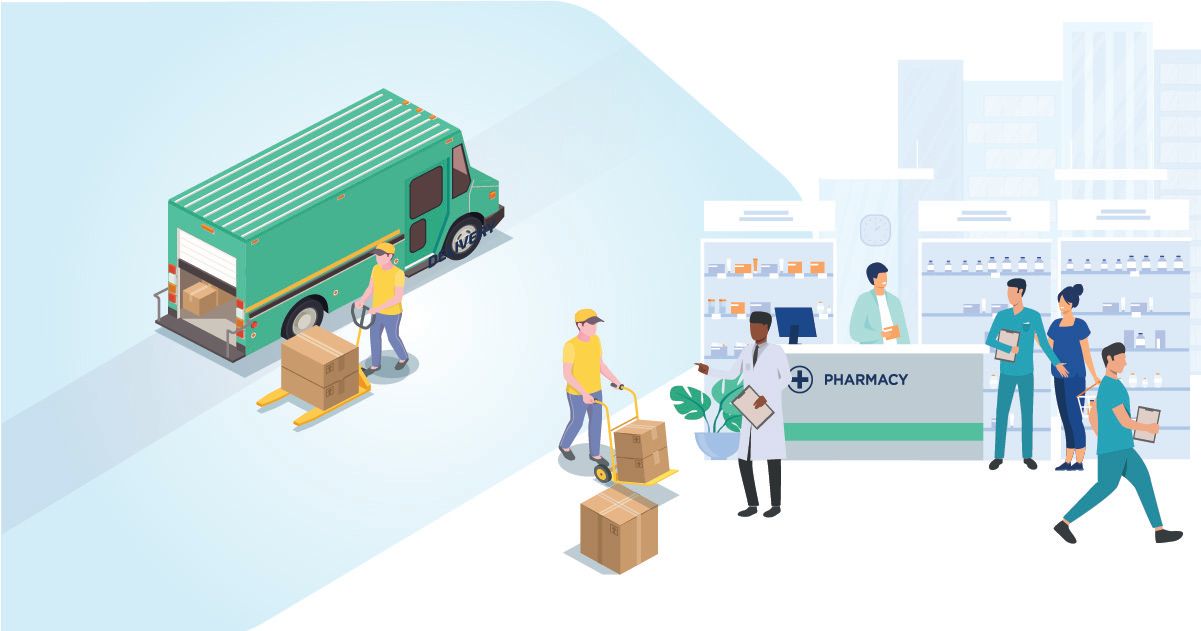
This article looks at the supply chain problems and bottlenecks the healthcare industry faces in the post-covid world. Additionally, it also looks at possible solutions that companies are currently employing to improve the efficiency of pharmaceutical supply chain management.
The supply chain is probably the most crucial element of any business. Globalisation and leaps in technology have made it possible for goods to be transported from one corner of the world to another. In contrast, it has also introduced several levels of complexity in its management, which has increased the chances of errors. Although a certain error level is managed in most sectors, there is absolutely no scope for error in healthcare or pharmaceutical supply chain management.
For decades, inefficiencies and lack of infrastructure for cold chain logistics have plagued the pharmaceutical logistics industry, but the problem was never in the limelight.
For decades, inefficiencies and lack of infrastructure for cold chain logistics have plagued the pharmaceutical logistics industry, but the problem was never in the limelight. However, the coronavirus pandemic exposed the faultlines in the healthcare logistics industry during both the first and second waves. Several of these failures had a devastating impact on people's lives, leaving millions infected and thousands dead.
Impact of the healthcare supply chain disruptions
- Disruptions in the supply chain of PPE kits, surgical masks, syringes, and other essential items due to inefficiencies in the global supply chain exposed thousands of doctors and healthcare workers across the globe and in India to coronavirus, resulting in them getting infected while several hundreds lost their lives to it.
- Supply chain constraints and inefficient management led to oxygen shortages across India during the second wave leading to death and havoc. The situation got so bad that the High Courts across the country had to intervene to mitigate the issue related to logistics problems between governments, private companies, and transporters.
- Covid-19 vaccines, whether it is Moderna, Pfizer, Covisheld, or Covaxin, had varying transportation requirements, requiring cold chain logistics. However, the lack of proper infrastructure and visibility in the supply chain process resulted in a shortage of coronavirus vaccines worldwide but primarily in tropical countries in Asia & Africa, where poor cold chain logistics infrastructure coupled with harsh summers made it impossible to transport certain vaccines.
- India faced severe infrastructural constraints managing cold chain logistics constraints and distribution for its ambitious mission to vaccinate all eligible populations with coronavirus vaccines under its Univeral Immunisation Programme (UIP). India has primarily relied on diesel-run refrigerated vehicles for cold chain logistics & transportation, which requires a continuous power source. However, the solution has been ineffective for the scale of the operation required for covid-19 vaccine distribution across the country, creating challenges for quality control.
Existing cold chain infrastructure has been inadequate for the coronavirus crisis, particularly for highly temperature-sensitive vaccines like Moderna & Pfizer, requiring temperatures of -20 and -70 degrees Celcius throughout transport. The problem of lacking the required cold chain logistics infrastructure is not new. A report published by Economic Times in 2016 highlighted that over 25% of vaccines which India administers under its Universal Immunisation Programmes go to waste due to lacking cold chain logistics infrastructure. In the case of BCG vaccines, the wastage is doubled to 50%.
A study conducted by GSI and Association for Healthcare Providers (India) (AHPI) titled, 'Building resilience in India's post-Covid healthcare supply chain,' published in April 2022, highlighted grave concerns over the status of the healthcare supply chain in the country. Some key findings include,
- Over 80% of pharmaceutical manufacturers lack supply chain visibility over supply chain operations till the point of care.
- According to their survey, over 69% of healthcare product manufacturers lack the capability for reverse logistics, which makes them unable to do product recall due to a lack of end-to-end visibility in operations.
- Due to inefficiencies in the supply chain, warehousing and logistics costs are 15% higher in India than the global average. The cost leads to reduced margins for businesses and high costs for consumers.
- Over 50% of pharmaceutical manufacturers face a 1% loss in sales due to pilferages and expiry.
- India pharmaceutical companies have an inventory period of 98 days compared to 64 days across top-class global pharmaceutical manufacturers resulting in inefficient inventory management. It drives up product prices due to high inventory holding costs.
According to a report by ATKearney published in 2021, India has the highest number of FDA approved sites after the US, and the pharmaceutical market stands at 30 billion US dollars. This section looks at key challenges and bottlenecks faced by the healthcare supply chain sector.
The Healthcare: new logistical challenges: 2021 State of Logistics article by Kearney lists four critical challenges from a US perspective in the healthcare supply chain sector. These challenges include,
- The rise of the customer-centric supply chain on the back of technology-driven last-mile delivery services of pharma goods requires equivalent logistics advancement. In addition, it presents the need to integrate technology like analytics, Internet-of-Things (IoT), and data-based demand projections, among others, to ensure efficiency.
- The rise of the requirement for speciality drugs primarily dispatched through 3PL providers has led to increasing complexity impacting the supply chain efficiency and distribution. Therefore, better trace and tracking mechanisms are needed for such 3PL providers to ensure they are compliant with regulations without negatively impacting their efficiency.
- Resilience requirement for supplies that concerns the stocking of inventory and warehousing is also an area that requires urgent attention. The pandemic showed us how supply chain disruptions could lead to artificial shortages causing tremendous pain and suffering for the consumers. Thus, the efficiency needs to be increased through better inventory management, safe & secure packaging and warehousing.
- Making the availability of medical equipment decentralised is also crucial to ensure the timely availability of essential drugs and pharma equipment to the end consumers regardless of their geographical location. It would require much better augmentation and utilisation of data for demand projections that could factor in potential disruption and navigate accordingly.
Focus areas to make the healthcare supply chain more efficient.
Considering the existing bottlenecks present in healthcare supply chain management and future challenges, we identify two areas that require the urgent attention of manufacturers and supply chain providers affiliated with the healthcare industry. However, it is crucial first to understand the stakeholders involved which, in the case of the healthcare industry, are manufacturers, distributors, providers, and consumers across different healthcare products.
Accurate and real-time inventory management
Inventory management is one of the most crucial elements which matches the supply and demand for medical goods. The poor visibility of the hospital's inventory impacts the augmentation of the supply of such medical goods. On the other hand, hospitals suffer from inaccurate inventory management, which is a result of reliance on outdated or legacy software used by them for tracking inventory, managing procurement, logistics, and other supply chain-related processes. Similar issues are found in hospitals across countries. The problem was further exacerbated during the covid-19 pandemic when we saw cases of hospitals running out of ventilators, crucial medical supplies, medicines, etc. The lack of accurate existing inventory of essential medical products resulted in the hospital failing to cater to the demand at the required time; thus, several patients suffered from shortages of critical medical supplies leading to death or making their situations worse.
Thus, there is an urgent need to implement technology to manage inventory and procurement at hospitals. The refusal to integrate technology into their operations has cost dearly to the hospitals, and thus, it should serve as a wake-up call to them. We advocate for cloud-based and data-driven inventory management software to be used by hospitals so the flow of accurate information related to the demand for critical medical goods can flow from the primary purchasers to the manufacturers and distributors.
Supply Chain Visibility
A significant chunk of inefficiencies across the healthcare supply chain can be attributed to poor visibility. Lack of access to centralised and real-time data sources and systems is a considerable constraint. As a result, the supply chain is broken and operates in silos regarding healthcare. Since managing logistics and the supply chain is not the core function of hospitals, they rely on distributors and third-party logistics or 3PL providers to manage it.
Similar to inventory management, many processes related to supply chain management still require a great deal of manual intervention, which makes the operations inefficient, non-flexible, and prone to inaccuracies. Thus, we suggest integrating procurement, inventory, and logistics with technology to eliminate manual interventions and make the flow of information related to the demand more linear. Moreover, the healthcare supply chain can be made more transparent, accessible, and efficient using automation and AI-based solutions, improving overall supply chain visibility.
Conclusion
This article first looked at the key elements in the healthcare supply chain and how bottlenecks and inefficiencies can have devastating consequences, as highlighted by the coronavirus pandemic. Lastly, we discussed the areas in the healthcare supply chain that require immediate attention across the stakeholders, them being supply chain visibility and inventory management. Exploring them, we understood how lack of transparency makes the supply chain further inefficient in the face of rising demand for medical goods.
Thus, we conclude by further emphasising the role of technologies related to supply chain management that can make the process transparent, automated and efficient. We recommend companies in the healthcare industries adapt to changing circumstances and shift from outdated and mainly manual interventions to manage their supply chain to a more organised, automated, and tech-driven one.
What is the healthcare supply chain?
Healthcare Supply Chain Logistics is a set of procedures, involving personnel from several teams and the transportation of goods that healthcare professionals need to do their duties, such as medications, surgical instruments, and other products.
What are the components of health supply chain management?
The main components of health supply chain management are : planning, Budget , organization and staffing, supervision, quality monitoring and evaluation, procurement, product selection, quantification, inventory management, advocacy and serving customers.


